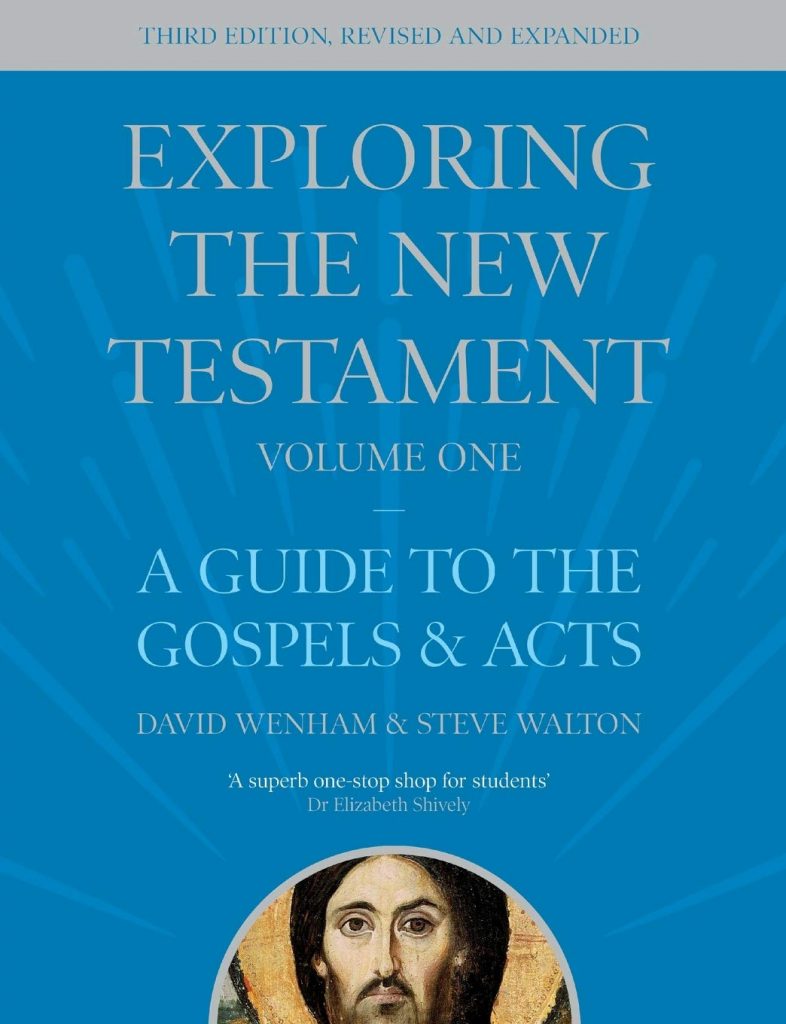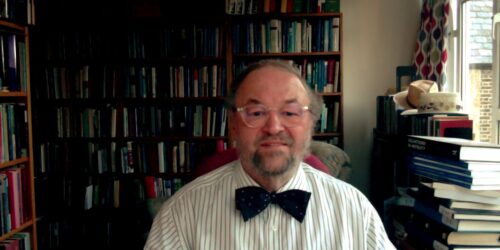An update to our Gospels and Acts textbook

The introductory textbooks Exploring the New Testament are a one-stop guide to engaging with the Gospels and Acts (volume 1) and the Letters and Revelation (volume 2). Published by SPCK in the UK and IVP in the USA, volume 1 has just appeared in a third, substantially revised, edition. The third edition of volume 2, revised by Stephen Travis and Ian Paul, will appear in May.
Here’s an interview which Ian Paul (IP) did with David Wenham and me (SW & DW) about the new edition of volume 1. Ian published this first on his blog, and it is reproduced here with his kind permission.
IP: How did your interest in this book start—what prompted your involvement?
SW & DW: David’s interest in the project came out of his own teaching first in India and then in Oxford; he has always wanted to make the New Testament and its context come alive for students, and to help people navigate the sometimes choppy and challenging waters of academic NT studies constructively and critically.
Steve’s involvement in the project began in his early days teaching at St John’s College, Nottingham (an Anglican theological college, alas, now closed). He was teaching a core course introducing the Gospels and Acts to students, and after a couple of years he became frustrated with the textbooks which were available then (mid-1990s). His frustration was that these books tended to tell students lots about the Gospels and Acts without engaging students in reading the Gospels and Acts for themselves. That led to a conversation with his then-colleague, Stephen Travis, who was involved in planning two books designed to help beginning students engage with the New Testament, and the invitation to be part of the project.
IP: The book has an interesting layout, with a mixture of features. What have been your aims in composing the book in this manner, and how has that worked?
SW & DW: In order to help people engage with the Gospels and Acts for themselves, we realised that we required a number of components, both in content and in the style and features of the book.
In terms of content, we give readers:
- a sense of the historical, cultural and theological setting of the Gospels and Acts (chapters 1 and 2);
- an understanding of the kind of books the Gospels are among ancient literature, so that they read them with eyes open to how they communicate (chapter 3);
- a grasp of the process by which the Gospels were put together, including an awareness of how scholars have studied them (chapter 4);
- a helpful approach to reading the Gospels today, using tools which scholars have developed to assist in that process. This includes how to read specific kinds of stories in the Gospels, especially parables and miracles, and a discussion of the historical value of the Gospels—about which we’re very positive (chapter 5);
- an overview of how scholars have understood the Jesus of history in relation to the Gospels, tracing some of the key figures in ‘historical Jesus’ studies, and considering some key issues, such as the plausibility of miracle accounts (chapter 6);
- a review of the life story of Jesus according to the Gospels, tracing the story from Jesus’ birth through to his death and resurrection (chapter 7);
- an outline of key themes in the teaching of Jesus which help us to see what his aims were: why he died, how he understood the kingdom of God, his teaching on ethics and the Jewish law, his understanding of his own identity and his place in the purposes of God (chapter 8);
- five chapters looking at each of the Gospels and Acts, starting with Mark, which we (with most scholars) see as the first to be written. These chapters focus on the content of the Gospels and their major themes first and foremost, and look more briefly at traditional questions of authorship and date—we want our readers to know the contents of these books (chapters 9–13);
- a glossary of key technical terms which readers can use—we provide brief definitions of the terms, and point to the pages in the book where readers can learn more.
In terms of style and features, we include:
- a summary of the key areas readers will learn about at the beginning of each chapter;
- charts, tables, diagrams, and maps to help readers visualise key things, or to provide summaries of key dates or people;
- boxes with brief information about key features of the topic or NT book being studied;
- ‘What do you think?’ boxes with mini-projects for readers to tackle to help them understand—these get readers to engage with New Testament texts for themselves with some guiding questions or issues to consider. These are typically 30–60 minute projects, and could be used as the basis for a class discussion or seminar;
- ‘Digging deeper’ boxes to engage more fully with a question or issue, again inviting readers to read the New Testament and think about what they read. These typically take 2–3 hours, and would be great for students to work on and then to lead a class where they share their discoveries;
- ‘Focus on theology’ boxes which develop a theological theme or topic within one of the NT books, providing a ‘worked example’ of how to read the Gospels and Acts to learn about God and God’s ways, by way of encouragement to readers to do the same themselves;
- ‘Some issues for today’ provides brief reflections on what the content of a chapter or major section implies for the life, faith, mission and ministry of the Christian community today—we ourselves are Christians, and so are many of our readers, and we want to help readers make the step from what the text said then to what it says now;
- suggested essay topics on the chapter or major section, divided into ‘Introductory’ (roughly, first year) and ‘Intermediate’ (roughly, second year);
- recommended further reading for each chapter or major section, with a note by each item saying what a reader will learn from the book or article, divided into ‘Introductory’ and ‘Intermediate’.
Many of these features were the result of Stephen Travis’ early work on a chapter on Hebrews for the Letters and Revelation book; when we saw his sample work, we agreed it was very helpful, and adopted Stephen’s model.
IP: This third edition has been fully revised and updated. What are the main changes that you have made in the material?
SW & DW: We have updated parts or added new sections where significant developments have happened in scholarly thinking about the Gospels and Acts since the second edition, ten years ago. We were surprised how much that meant!
We’ve also created a companion website for the new edition of both this and the second volume on the Letters and Revelation. There we make lots of excellent photographs of places and objects freely available (taken by our co-authors for the Letters and Revelation volume, Stephen Travis and Ian Paul), as well as the diagrams, charts, maps and tables from the book, and links to key extra-biblical texts (such as Josephus). The website is designed for teachers and students to download and either print or use in slide presentations for classes. The images are searchable by chapter of the book, or by place, person, chart or biblical reference. There are already a wide range of resources, and this collection will continue to grow over the coming months.
Specific changes and updates include:
- introducing discussion of orality and social memory theory and their impact on Gospels studies;
- adding a new section on ‘Reading the Gospels and Acts theologically’, drawing on the work of Tom Wright and others;
- writing a new section on ‘How the Gospels and Acts read Scripture’, looking particularly at the impact of Richard Hays’ important work;
- adding a new section on Jesus and women;
- substantially expanding the section on Jesus’ resurrection;
- expanded discussion of the process of writing the Gospels in the light of new research by Michael Licona and Richard Bauckham;
- adding a section on Jesus’ identity and mission in Luke;
- expanding discussion of John’s ethics and authorship;
- adding a section on the ascension of Jesus in Acts;
- reviewing all the further reading lists, which resulted in adding new sources which have appeared since the second edition ten years ago, especially including those by women, and by scholars of non-white ethnic groups and non-western cultures. We removed some older (and less relevant) sources. We’ve also added further reading specifically on Matthew’s sermon on the mount (Matthew 5–7).
IP: What has been happening in the study of the gospels and Acts in the last 20 years—what are the main changes and developments?
SW & DW: Five developments come to mind quickly—we’re sure there are lots of others too!
First, the Gospels and Acts are being read more holistically, rather than classical source, form and redaction criticism, which focused on how the authors got their material and put it together into our Gospels. Recent work tends more to reading Gospels as whole documents, resulting from narrative and literary approaches which came into New Testament studies in the 1980s, and which are now bearing fruit in lots of fascinating work, including some fine commentaries. Jeannine Brown’s recent fine book, The Gospels as Stories, does a wonderful job of opening up the effect of such approaches in reading the Gospels by providing good theoretical discussion followed by excellent worked examples of reading a topic of theme using the theory outlined.
Secondly, a fresh case has emerged for the historical value of the Gospels as sources for Jesus, and Acts as a source for the earliest churches. Richard Bauckham has been a major influence here with his Jesus and the Eyewitnesses, which has gone through two editions and has provoked lots of response and debate. Bauckham argues cogently that eyewitness testimony stands behind the Gospels, and thus that we can substantially trust their portraits of Jesus. David Wenham himself has contributed to this discussion in his work on the way that tradition about Jesus known from the Gospels can also be found in Paul’s letters.
Thirdly, theological reading of the Gospels and Acts has become important. Scholars such as Stephen Fowl have got us thinking about the message of Scripture, the world ‘in front of the text’ where we as modern readers engage with the text as a resource for our Christian thinking, living and believing. This growing movement includes reading the Gospels and Acts—and the whole Bible—with earlier readers, such as the ancient fathers and mothers of the church, and the sixteenth-century reformers. Several series of ‘reception history’ or ‘history of impacts’ commentaries are now helping us read with these earlier readers, such as IVP-USA’s two series, the Ancient Christian Commentary on Scripture and the Reformation Commentary on Scripture.
Fourthly, and related to theological reading, scholars have given sustained attention how the Gospels and Acts ‘read’ Old Testament Scripture. Notable here is the work of Richard Hays in two important books on the Gospels, but he is far from alone. Hays’ use of ‘metalepsis’ is crucial—the idea that a snippet from the OT being quoted or echoed in the NT can ‘pull with it’ the story or passage on the OT as a guide to interpreting the NT passage. Hays is developing and using an idea which came into NT studies with the work of C. H. Dodd in the 1950s in his According to the Scriptures, and looks very much like an idea whose time has come.
Fifthly, the now-widespread view that the Gospels are akin to ancient biographies, argued by Richard Burridge and others, is bearing fruit in some fine work reading the Gospels this way. Helen Bond has recently published a valuable discussion of Mark as biography in conversation with other ancient biographies. Michael Licona has used the biographical nature of the Gospels to provide a valuable comparison with the biographies of Plutarch, which illuminates why there are the kind of differences there are among the Gospel accounts. Craig Keener has written a fine study, Christobiography, showing how the biographical nature of the Gospels helps understand their message about Jesus.
IP: What do you find most exciting in the discipline of biblical studies at the moment?
SW & DW: There are lots of exciting things, for example the renewed scholarly interest in the earliest oral traditions of Jesus. Then there is the huge amount of informative scholarly work being done on the historical and social background to thee New Testament, not least on Palestinian archaeology, by scholars such as Craig Evans and Rainer Riesner.
Further, something quite different: the care with which scholars young and old are reading the Bible is an encouraging feature, as is their frequent desire to engage creatively with Scripture in relation to today’s church and world. Both of us have enjoyed working with some fine doctoral students who are becoming the next generation of biblical teachers in theological colleges, seminaries, universities, and churches around the world. The cross-fertilisation between scholarship in the west and the majority world is a key feature which will become ever more important as the church’s base is increasingly not in the western world. It’s exciting to see growing numbers of scholars who are not all male, white and western, and to learn from the concerns and questions they bring to reading Scripture.
IP: What do you see as the main challenges for the churches in their engagement with Scripture today?
SW & DW: Simply engaging with Scripture would be good! The general lack of knowledge of Scripture in western churches is distressing, and both of us have experienced this in having to start further back in teaching the Gospels and Acts to students than thirty years ago. Many students in theological college who are training to be ministers and pastors have come to faith from non-Christian backgrounds and, through no fault of their own, have a long way to go in getting to know the contents of Scripture. In this, they reflect the congregations from which they come. Our friend Lucy Peppiatt wrote a blog post in 2019 about the dangers of a theological fast food culture, and comments there on the positive response she got to speaking very straightforwardly from the Bible at a major charismatic Christian conference, without the usual ‘here’s what God did for me’ stories and clever jokes . Our concern to help people read Scripture for themselves is, to turn full circle, what led to this book!
IP: Thanks for your time—and I hope the books are widely used.
Steve Walton is (part-time) Professor of New Testament at Trinity College, Bristol. He is writing a major commentary on Acts. He lives in west London with his wife, Ali, who is a vicar, and their Border Terrier, Flora.
David Wenham has taught New Testament at colleges in India, Oxford (Wycliffe Hall) and Bristol (Trinity College), as well as being visiting lecturer in South Africa, Zimbabwe and the US. He is now retired and lives with his wife Clare in an edge-of-Oxford housing estate, where he continues his writing work as well as being involved in the local church.




